RIC-3531 Primary Science - Book D (Digital)
You also want an ePaper? Increase the reach of your titles
YUMPU automatically turns print PDFs into web optimized ePapers that Google loves.
Our Environment<br />
Changes to the Local Environment – Activity 1<br />
Lesson Focus<br />
Outcomes<br />
Earth and Beyond<br />
2.2 Describes changes<br />
that occur in the local<br />
environment.<br />
Indicators<br />
• Recognises factors that<br />
create our environment.<br />
• Identifies that some<br />
influences on our<br />
environment can have<br />
negative and positive<br />
effects.<br />
Skills Focus<br />
• Observes<br />
• Records<br />
• Interprets information<br />
Background Information<br />
Some changes to the<br />
environment benefit it, other<br />
changes benefit the people<br />
who live in that environment.<br />
Many human-made changes<br />
have a great influence on<br />
the natural environment.<br />
Unfortunately, these influences<br />
usually have a negative impact.<br />
Today we are very aware that<br />
the way we live can damage<br />
the environment. We are<br />
now more educated about<br />
environmentally friendly ways<br />
to live than ever before. To try<br />
to repair some of the damage<br />
we have created, we now<br />
recycle rubbish, use aerosol<br />
cans less frequently and try<br />
to car pool or ride bicycles to<br />
work and school. Hopefully,<br />
these small steps will start to<br />
rectify some of the negative<br />
impacts that humans have had<br />
on the natural environment in<br />
the past.<br />
Before the Lesson<br />
Materials Needed<br />
A3 paper, coloured pencils, pictures, charts or books showing natural or damage to<br />
the environment (e.g. erosion, deforestation)<br />
Preparation<br />
Organise the students into pairs or small groups for the second part of the activity.<br />
The Lesson<br />
Stimulus<br />
• Write the word ‘environment’ on the board. Brainstorm words and images about<br />
the environment until the board is full. As a class, create a definition of ‘the<br />
environment’. (Environment – The physical conditions of a place such as weather,<br />
water, vegetation and surrounding influences.)<br />
What to Do<br />
• Discuss what makes up the environment. Explain that it is not just people, plants<br />
and animals but also the air, the ground we stand on and the places we live and<br />
work. Students complete Question 1 on the blackline.<br />
• In pairs or small groups, students discuss and write examples of each of the four<br />
influences on the environment. If they find it difficult to write the positive effect<br />
of people on the environment, remind them that we are now trying to fix our<br />
damage.<br />
• Students share the results of Questions 2 with the class.<br />
• Focus on the positive effects of people on the environment. Make a list of ways we<br />
are now trying to rectify the damage we have caused. Obviously some damage is<br />
irreparable, such as land that has been cleared to build cities and homes.<br />
• Students work together to create posters that remind us of ways we can help to<br />
conserve the environment.<br />
After the Lesson<br />
Answers<br />
1. Teacher check<br />
2. (a) Possible answers<br />
• rain: good effect – animals, plants will flourish, soil will hold together and<br />
not be blown away, bad effect – flooding, destroy crops and soil.<br />
• logging: good effect – we have furniture to sit on, paper to write on and<br />
houses to live in, bad – forests destroyed, land cleared and soil in bad<br />
condition.<br />
• fire: good effect – germinate seeds providing food for animals and plants<br />
to flourish, bad – destroy plants and animals, destroy their homes and our<br />
homes.<br />
• people: bad effect – pollution, logging, mining, greenhouse effect, landclearing,<br />
overpopulation, extinction of animals, good effects – in the<br />
last twenty years, we have begun to consider the consequences of our<br />
actions. We now recycle, use less chlorofluorocarbons, car pool, conserve<br />
environments to prevent animal extinction and much more.<br />
Additional Activities<br />
• Students choose one way of conserving the environment to research. They use<br />
books and the Internet to find information and present it as a poster.<br />
• Students spend a weekend at home making records of things they can do to be<br />
environmentally friendly. These can include saving electricity by turning lights off,<br />
not using aerosol cans, saving water and recycling rubbish.<br />
• Students research National Parks and the reason we have them.<br />
Display Ideas<br />
• Display student posters.<br />
32 PRIMARY SCIENCE ~ R.I.C. Publications ® ~ www.ricpublications.com.au<br />
ISBN 978-1-925660-54-8<br />
©R.I.C. Publications<br />
Low Resolution Images<br />
Display Copy


















